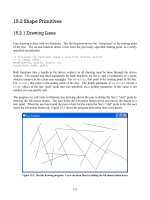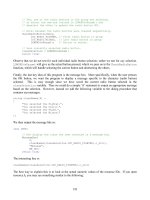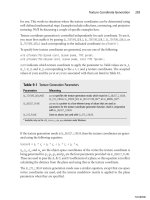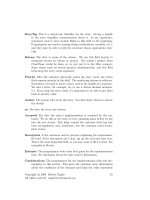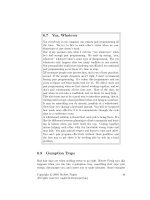Planning Extreme Programming - kent beck martin fowler phần 7 doc
Bạn đang xem bản rút gọn của tài liệu. Xem và tải ngay bản đầy đủ của tài liệu tại đây (89.67 KB, 16 trang )
Is it bigger than a breadbox?
20 Questions
Base estimation on finding a similar piece of work that you’ve
already done. It’ll take about the same amount of time as that.
How do you come up with estimates? We’ve seen a lot of words
devoted to this topic. We’ve seen quite a few mathematical formulae.
The best of these are based on the lines of code to be written. These
can tell you how much time it will take to develop so many thousand
lines of code. This is particularly useful since it’s so easy to estimate pre-
cisely how many lines of code a solution will be before you start writing
it. (Spotted the sarcasm yet?)
Let’s be clear, estimation is a black art at best. You’re not going to
get accurate figures however hard you try. You can, however, get good
enough numbers with a little bit of effort, and you can get better num-
bers over time.
There are two keys to effective estimation
✧
Keep it simple
✧
Use what happened in the past
The best guide to estimating the future is to look for something that
happened in the past that was about the same as the future thing. Then
just assume that history will repeat itself, as it often does. If there’s a
significant difference between then and now, then use a very simple way
to factor it in. Don’t try to be too sophisticated, estimates will never be
anything other than approximate, however hard you try.
Chapter 19
Estimation
100
Estimating the Size of a Story
A simple, yet effective way to estimate the size of a story is to look for
a similar story that you’ve already delivered. Then look at your records
to see how long it took to build. Then assume the new story will take
the same amount of effort. "Oh, another report. Reports always take us
a week."
What if all the stories were the same size? Then estimating them
would be easy. They are all, ehem, the same size. All that you would
have to do is see how many stories the team completed each iteration
and you would know how much you could get done.
We don’t know how to make all the stories the same size. However,
relative sizes work just as well as absolute sizes for planning purposes.
Our approach is to look at the previous stories that got built. If you
find one that looks to be equivalent to the one you are considering,
give it the same estimate. "Oh, another report. Reports always take us a
week."
If you can’t find one the same size, look for something half as big or
twice as big. Multiply or divide as appropriate. Do not worry that Mar-
tin probably failed to get an A in his Further Maths A level because of
his unfortunate habit to multiply by two when he should have divided.
You’re a lot cleverer than he is.
It doesn’t actually matter what units you express the estimate in. The
only important thing is that you use a consistent unit between what you
did and what you estimate for the future. In this book we use ideal
weeks. Ideal weeks are the number of weeks that the story would take
to one pair to implement, if the programmers could dedicate 100% of
their time to it.
(You’ll notice a slight flaw in this approach. How do you estimate
when you haven’t built anything yet and you don’t have anything to
compare it to? See Chapter 22 for a thoroughly unsatisfactory solution
to this problem.)
Estimation is a team effort. The team discusses the story, considers
how long it may take to implement, and decides upon an estimate. It
may be that the team members will disagree regarding the estimate.
Some may think the story is hard and will take a long time to develop.
Others may think it is easy, and will take a short time to develop. We
101
follow the rule: “Optimism wins”. That is, if after reasonable discussion
the disagreement persists, we choose the shortest estimate.
Remember, estimates are not commitments. And a couple of bad
estimates are not disasters. What we are aiming for is to continuously
improve our ability to make estimates. By choosing the most optimistic
estimate we accomplish two things. We keep tension in the estimates so
that they don’t grow hideously long; and we keep tension in the team
so that the team learns not to be too optimistic. Team members, whose
optimism burned the team once, will learn to temper that optimism.
Another issue that worries many people is dependencies between the
stories. As we say in Chapter 20, you can mostly ignore dependencies.
However mostly doesn’t mean alwaysly. You will get some cases where
you say “flooping the thingummy will take six weeks, but if we do it
after we burble the foobar it’ll only take four weeks”. In this case use
the appropriate number for flooping depending on its position and
make a note of the assumption. You will only have a few of these.
Periodically you will re-estimate every story, which gives you a
chance to incorporate additional information like dependencies that
have been erased or technologies that turn out to be difficult (or easy,
we suppose).
Estimating How Much You can do in an Iteration
You can think of each iteration as a box, each of which can hold a
limited number of wine bottles. The key question to any oenophile is
how many bottles can you fit in a box? You could measure the box,
measure the bottles and do some geometric analysis, you could form a
committee of august persons, or you could just try it and see.
We like the latter approach. At the end of each iteration we measure
how much stuff got done. We assume that, on average, we’ll get the
same amount of stuff done next time. Life being what it is the amount
of stuff will change from iteration to iteration, but we should see a rela-
tively steady number over time.
Counting stories is not quite so easy as counting wine bottles, as not
all stories are of the same size. So we have to measure the size of each
story. At the end of each iteration we look at all the stories that got
done, and we record how many weeks of ideal time it took to do each
story. We then add up all the ideal time in all the stories, and that tells
102
us how much ideal time there is in each iteration, we call this figure the
velocity of the team.
Following this simple rule violates one of the dictums of project man-
agement, "Work expands to fill the available space." The project man-
ager on one of Kent’s projects recently allowed as to how this just
wasn’t true, since the team had delivered 37 days worth of stories after
having initially committed to 23, and done it with two people sick the
entire time.
Be very wary about adjusting velocity to cope with changes in a
team’s size. As we discussed in Chapter 12 changing the composition of
a team has both a non-linear and delayed effect on velocity. So we pre-
fer to not predict the effect, but instead record velocities and see how
they change. This is particularly true as you add people, since you rarely
know how long it will take for the addition to take hold.
We also use velocity for individual developers. A programmer with a
velocity of 10 ideal days can sign up for 10 ideal days of work in each
iteration. Most developers will have the same velocity. However if
someone is working part time, or is new to the team they will have a
lower velocity.
You have to be careful not to attach too much meaning to velocity.
Say you have two teams of the same size with the same iteration lengths
but different velocities. What does this mean?
The answer is all sorts of things tangled up together. It might mean
one team is more talented, or that one team had better tools. But it
might also mean that one team tended to use more optimistic estimates
than the other and needed a smaller velocity to compensate. In the end
all of this stuff about ideal time is one almighty fudge to compensate for
the difficulty of estimating software development.
The Meaning of Ideal Time
There’s been a fair bit of discussion in the XP community about how
what units of effort we should use.
In many ways the simplest unit would be calendar effort, which is
based on calendar time.
103
Calendar time is the familiar passage of time, modified to handle
working days. So if you are working Mondays to Fridays then four cal-
endar weeks is equal to 20 calendar days.
Calendar effort is amount of people times calendar time. So a team
of six people has 30 calendar development days of effort available per
calendar week. In four weeks they would have 24 calendar development
weeks of effort available. If one person on the team worked half time,
they would have 22 calendar development weeks of effort available in
that same four week period.
Most people measure all tasks in terms of calendar effort. This makes
sense because it’s easy to measure. However it makes estimating harder.
The key to estimating is to consider people working at a reasonable
sense of efficiency. Typically this means they don’t get interrupted and
distracted by the typical distractions that affect everyone all the time.
These even out over the long haul but can have a big effect in short
periods of a week or two. As such they really make a mess of historical
data that is the backbone of a good estimation system.
So in XP we come up with a second kind of time: ideal time. Ideal
time is time without interruption, where you can concentrate on your
work and you feel fully productive. We measure and estimate using
ideal time, because that allows us to compare tasks without worrying
about interruptions. If we look at a task and see it is about as compli-
cated as one that took 2 ideal days last week, we can estimate it will take
two ideal days this week. The elapsed time could well be very different,
but that is something we monitor separately.
We use the term ideal time, but really it’s ideal effort. A team of six
people might have 10 ideal development days of effort available a week.
Typically when people talk of task lengths they say “that’ll take 3 ideal
days”. What they really mean is that it will take “three ideal develop-
ment days”, but that’s too much of a mouthful.
The notion of ideal time has really little to do with time. Indeed
some people like to use something like story points, task points or
gummy bears to measure the effort for stories and tasks. This works
since the only important thing is that you have the same unit for the
actual stories you measured in the past as you use for your estimates.
104
We like ideal weeks because it has some correspondence to the famil-
iar, yet the word ideal is there to remind us that things aren’t perfect. It
also can help early on when doing your first plan (Chapter 22).
(If you’ve read some older stuff on XP you’ll come across the term
load factor. Load factor is the ratio of the calendar effort in an iteration
and the velocity. So a team with 5 people using two week iterations has
10 elapsed programming weeks per iteration. If it’s velocity is 4 then it
has a load factor of 2.5 (10/4). We used to use load factor a lot in plan-
ning, but since learned that it’s easier to just use velocity, so now we
don’t use load factor any more.)
Improving your Estimates
The good news about this estimation process is that tends to
improve. As you do it more often, as you build up more actual figures,
everyone in the team gets better at estimation. Encourage this process.
Don’t expect too much of early estimates, but do expect them to
improve.
For this to work you need to track your actuals. Make sure you
record how long it took to do a story. The record shouldn’t be any
more precise than your planning precision, so to the nearest ideal week
will be fine. Building up a good set of actuals is essential to improving
the planning process.
The most important stories to do first are the ones that contain
the highest business value. It is also valuable to do high risk sto-
ries early on. Beware of sequential dependencies, most of the time
they are false.
One of the key parts of planning is deciding what order you should
do things. There is never any shortage of things to do. What should we
do today?
Sometimes software is just too complicated, so instead let’s consider
something that is both more mundane and more essential. In cooking
you answer this question by looking at the timing and sequencing in
the recipe. Often there is quite a strong ordering involved: you have to
fry the onions golden before you put in the chicken.
This notion of ordering is the dominant aspect of most kinds of plan-
ning. On big engineering projects this is what leads to the practice of
dependency analysis and Pert charts. Dependencies between tasks dom-
inate planning. Your mission, should you choose to accept it, is to find
the best way of navigating through the dependencies.
To plan in this style you need to layout a list of tasks and capture the
dependencies between the activities. By looking at these and looking at
the duration of the activities you can figure out the key activities on the
critical path where a delay will effect the whole project. If you do a
course on project management you’ll usually spend a good bit of time
on this kind of analysis, together with such topics as resource leveling.
You may well use a computer tool to help deal with all of this.
All of these techniques are pretty much useless on an XP project.
They are useless because dependencies between tasks do not figure very
Chapter 20
Ordering the Stories
106
much in the picture. Most of the time there is no necessary ordering
between the stories. You can build them in any order you like. We don’t
a proof for this, but like most software pundits that never stopped us
from a brave assertion. Our evidence is simply that nearly every time
someone comes up with an ordering constraint, we can shoot it down.
A good example is a project Martin ran into for doing costing analy-
sis for a factory system. The cost models were complicated and very
new, so were not well understood. They ran on a large amount of data.
The project team reasoned that since the models needed the data, the
software to enter the data needed to be written first. This meant build-
ing a lot of GUI screens to enter and validate the data.
That was a false dependency. The data could be put into the database
using raw SQL. This would allow them to work with the costing mod-
els and figure out what the models were really about. Until they under-
stood the models better, they were hardly able to know what data they
needed. Running the models was the point of the application after all,
the data was only there to serve them.
We believe that most ordering dependencies are false. Of course most
isn’t all, but the cases where you do get dependencies they are easy to
deal with on a case by case basis, either inside of an iteration where you
have control, or by modifying estimates midstream. They don’t affect
the overall plan much.
A logical, yet naïve, reader would see this lack of constraints as a ben-
efit. But often it isn’t. Instead we see people who are looking for depen-
dencies, and are so determined to find them they find dependencies
that don’t exist. After all if there is no ordering constraint, how do we
choose what order to do things?
Business Value
So we need different factors for our choice. The first of these is busi-
ness value. Do those stories that yield the most benefit to the custom-
ers. This seems so obvious that we hardly feel the need to point out
why. But just in case, we’ll do it anyway.
We want to get a release to the customer as soon as possible. We want
this release to be as valuable to the customer as possible. That way the
customer will like us and keep feeding us cookies. So we give them the
things they want most. That way we can release quickly and the cus-
107
tomer feels the benefit. Should everything go to pot at the end of the
schedule, it’s okay, because the stories at risk are less important than the
stories we have already completed.
Even if we can’t release too quickly the customer will be happier if we
do the most valuable things first. It shows we are listening really trying
to solve their problems. It also may prompt to the customer to go for
an earlier release once they see the value of what appears. Early releases
scare people who do prototyping, because prototypes aren’t production
quality. But XP never builds anything it can’t be proud of, so we can
deliver at any moment.
How do we measure the business value of a story? The short answer
is that we don’t, that is the developers don’t. Business value is a deci-
sion entirely within the realm of the business people. It’s their business,
so they know what the value is. If they’re wrong, well they’re paying for
it. If you have enough dollars you have the right to wrong. The devel-
opers can suggest alternatives and ask questions. But in the end busi-
ness value is always a business call.
How carefully should you figure out their values? You don’t need to
get it to the dollar, indeed it usually isn’t worth trying to put a dollar
value on it at all. The relative values are what counts, and you only need
a rough sense of the relativity.
This is enough to start with. As you play out the release plan, you’ll
allocate the stories into iterations, and that will lead to a finer determi-
nation of business value. But in order to do that the business needs
some more information.
Imagine you’re standing in front of the new car that you’ve been sal-
ivating over for years. Finally the old heap has thrown a rod and you
can reward yourself with nearly a year of that new car smell. You’re
finalizing the deal and the salesman asks “would you like the optional
sun roof with that sir?” What do you answer?
Unless you’re either incredibly cheap, or incredibly rich (or incredi-
bly against fresh air) you’ll want one piece of information. How much is
that window in the Rover? If the cost is $10 you'd probably take it. If
it’s $10,000 you’ll probably pass. But if the range is that big, you can’t
decide without the cost.
For most software, the range is that big.
108
So who gets to allocate the cost? Development states the cost, and
they state it by estimating how much effort it will take, see Chapter 19.
Technical Risk
As development looks at the stories they will inevitably start thinking
about how they will build them. As they do this they will run a gamut
of feelings; all the way from “piece of piss” to “can’t be done”. These
feelings are important, because they are the manifestation of where the
project could go off the rails. When developers feel nervous, everyone
should listen.
The nervousness comes from a number of sources.
✧
Development may not be confident that they can estimate the
story to the required precision. This could take a programmer one
week, or it could take twenty. That’s too big a range. It’s not
enough to split the difference and say ten. That may be a start, the
best you can do, but you need to know more. The risk here is that
the estimate could be off, and off badly.
✧
Development fears that working on this story late could cause a
lot of rework on the existing code base. Of course we XPers like to
believe the cost of change curve is flat. But while we are extreme,
we’re not stupid. Most of the time we can get away with that
assumption, but sometimes we can’t. Those cases when we can’t
are risky, and need to dealt with earlier.
A story may depend on some third-party piece of software. Software
developers are very distrustful of marketing blurb. The software may
say it can do something, but can it really? Until we know for sure, there
is risk.
Worst Things First
Why do the high risk items first? High risk usually means hardest.
Why not work on easier stuff early on and work your way up to the
hard stuff?
The primary reason is that risk implies uncertainty in the schedule,
that is the cost, of the story. If some features are going to cost a lot
more than development thinks, then business needs to know as soon as
possible. These surprises are going to happen, because software devel-
109
opment is inherently a surprising activity. The important thing is to dis-
cover them while you still have time to do something about it. That's
why so much of XP's planning is about uncovering risk early on.
Also tackling hard things early does wonders to reduce fear. If you're
working on something easy, and know there's something hard later,
there is always nagging doubt. The doubt saps confidence, it leads peo-
ple to over-design in order to make things easier later, it gnaws at the
relationship between development and customers, and the relationships
within the team. So it's better to know the truth early. Most of the time
it's easier than people think, especially when simplicity is the driving
force. When it isn't at least you know how bad it is, the team knows
how bad it is, and business can be told how bad it is. Once you know
the score, you can figure out what to do about it.
One exception to this rule is early in the process with a newly formed
or untrained team. If you have a team that hasn't worked together
before, the biggest risk is that they won't find it easy to work together.
So working on something easier in the first iteration makes sense. But
as soon as they start working together they need to handle the hard
stuff. That way they can get used to working on hard stuff before the
pressure builds. Similarly if you're working with a new language or plat-
form, your biggest risk is that you don't know how to work in that plat-
form. So tackling something easier can concentrate on acquiring that
learning, before hitting the big stuff. However if you're in a team that's
worked together before in an environment that you know, then go full
tilt at the biggest, meanest monster you can see — however many teeth
it has. Just push those teeth right down that throat. Or run away and
choose another path. Either way figure out which you need to do as
quickly as you can.
Performance
Performance is on of the seemingly technical factors that "ought" to
affect the schedule. However, the trade-off between investing in perfor-
mance and investing in more functionality is a business decision. A
blazingly fast system that doesn’t compete on features is just as dead in
the marketplace as a feature-rich system that doesn’t perform.
The programmer’s job on performance is to make sure the trade-off
is clear. "You can have that feature in two weeks, but it will only work
110
for up to 100 hits/hour. If you want 10000 hits/hour it will take us
four more weeks." If the customer wants the slower version first, write
another story for the optimization.
The same is true for other non-functional requirements, like reliabil-
ity. Communicate the trade-off between various levels of service and
speed of implementation. Let the customer decide.
This frightens some technical folks. What if the customer drives the
team down a blind alley? That can happen. But grabbing the wheel
from the customer and making business decisions for technical reasons
won’t solve the problem. The best you can do is make the trade-offs
clear, and do your best to keep your options open by having extensive
tests, keeping the system clean and orderly, and staying rested.
Negotiating between the two
You notice we have two different criteria set by two different groups
of people. How do we resolve between the two of them? We want to
tackle the high-risk and high-value stories first. However there are
plenty of times when the conflicting priorities have to be dealt with.
Ideally it is business who should make all these choices. Business peo-
ple understand uncertainty in estimates, they face this all the time with
financial projections. They also understand the cost of rework in the
cases where rework is an issue. If they wish to run the risk in order to
get better value now, then that is really their call. It is the developers'
task to make the risk apparent, not to make the decision for the cus-
tomer. However while this is the ideal, sometimes you need something
extra to make it work, perhaps allowing developers to choose a certain
amount of stories per iteration so that they can bring the risk forwards.
We need to stress that you shouldn't worry too much about the issue
of rework. If you spend a lot of time trying to figure out the conse-
quences, or trying to figure out the best order to do them in, then
you're wasting time. It would be useful if you could figure all this out
correctly, but our experience is that it's nearly impossible to figure it
out correctly.
111
Example Release Plan
Let’s take a look at the release plan from the time capsule. The infor-
mation was annotated on the cards, but we’ve transposed it all into a
handy table for you.
Story
Time
Estimate
Assigned
Iteration
Assigned
Release
Find Lowest Fare 3 2 1
Show available
flights
211
Sort available flights
by convenience
42
Purchase ticket 2 1 1
Customer profile 4
Simple Customer
Profile
211
Full Customer Pro-
file
3
Review itineraries 1 2 1
Cancel itinerary 2 2
Print immigration
paperwork
4
Show Hotels 3 2
Show hotel availabil-
ity
2
a
2
Sophisticated Hotel
Search
3
Book a Hotel 1 2 1
TABLE 1. Example Release Plan
112
The notes indicate a velocity of 6 and as you can see stories have been
assigned to iterations. There’s a release after the first two iterations and
a further release two iterations later. (The releases are a little short, but
this is enough for an illustrative example. And in any case there’s this
confidentiality agreement which stops us showing all the plan two cen-
turies before we begin.)
There’s a few things worth noting:
✧
The Customer profile story has been split up into two parts with
different priorities. The estimates don’t add up in this case. Often
they do, but from time to time they don’t. That’s not an error,
each story should be estimated independently, so it does happen.
Maybe breaking it apart made us realize it was bigger than we
thought, or maybe doing them separately would take longer. The
reason usually isn’t important, so there’s no need to document it.
✧
The second iteration only has five ideal weeks of stories assigned
to it, even though the velocity is six. That’s okay — it’s important
for the capacity not to exceed the velocity, but the reverse isn’t
true. In this case additional work may well get added closer to the
iteration’s date, probably by splitting one of the later stories.
✧
A note on the card for Show hotel availability indicates that the
estimate depends on other work. That’s not uncommon, but it
isn’t worth making a fuss about. In this case it was probably only
recorded as the customer was figuring out what to put in iteration
2.
✧
It may look odd that Book a Hotel is assigned to iteration 2 when
Show Hotels isn’t assigned yet. How can you book a hotel if you
can’t see the list? The point here is that the functionality won’t be
available to the user yet, but will be built into the system and can
Hotel / Spaceline
programs
3
Airplane hire 3
a. Is 4 if Show hotels isn’t already there
Story
Time
Estimate
Assigned
Iteration
Assigned
Release
TABLE 1. Example Release Plan
113
be functionally tested to satisfaction of the customer. Not all
behavior has to be usable by the user to be included in the itera-
tion, the key criteria is that it is testable. You’ll often find this in
cases where you need to build functionality in the core business
logic but don’t add the UI until a later iteration.
✧
You’ll notice there are no details about the iteration length or size
of team. This is deliberate to point out that you actually don’t
need that information for the basic release plan. All you need is
the estimated stories and the velocity. Obviously you’ll need the
current date and the iteration length to tell people when an itera-
tion will be done. Something along these lines:
✧
It’s comforting to know that even in the 24th century they use
two digits for the year.
TABLE 2. Iteration completion dates
Event Date
Start 1 Apr. 29
Iteration 1 Com-
plete
19 Apr. 29
Iteration 2 Com-
plete
10 May
29
114



